duets: flute and piano
Altès - Premier Solo pour La Flûte - Flute & Piano
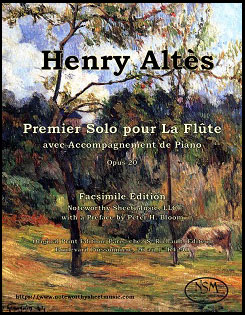 Premier Solo pour La Flûte, Op. 20, by Henry Altès
Premier Solo pour La Flûte, Op. 20, by Henry Altès
Facsimile Edition by Noteworthy Sheet Music
with a Foreword by Peter H. Bloom
Flute Part and Piano Score, PDF $12.75
Henry Altès (1826-1899) is primarily remembered today as the author of a particularly useful Méthode Complète de Flûte (1906), yet his impact on fellow flutists for nearly a century-and-a-half can hardly be overestimated. A student of the Boehm flute pioneer Louis Dorus, Altès succeeded Dorus as Professeur au Conservatoire de Parisupon upon the latter's retirement in 1869 and served in that capacity for a record twenty-eight years. Premier Solo pour La Flûte was dedicated to Louis Dorus, and was the first of ten Morceaux des Concours that Altès would write for the annual Paris Conservatory competition. That this was the only one of the ten to have been required in two contests speaks to its endearing durability. (excerpted from the foreword by P. H. Bloom)
The NSM edition of the Premier Solo pour La Flûte avec Accompagnement de Piano by Henry Altès is an “enhanced” facsimile of the original print publication from Paris, chez S. Richault, Editeur, Boulevard Poissonniere, 26 au 1er, R4241. We used an image editing program to clean up digital scans of the original printed pages and make a few minor modifications and corrections, as noted in our publication. We have added a new cover page (paying tribute to Altès’ birthplace of Rouen with a painting by Gauguin) and a foreword by Mr. Bloom, but the music has not been re-notated and thus remains in the original style and format; please have a look at the free preview pages provided before ordering.
Piano and Flute score, 12 pages; Flute Part, 5 pages; Total, 22 pages.
PreviewBeach - Romance, trans. for Flute & Piano
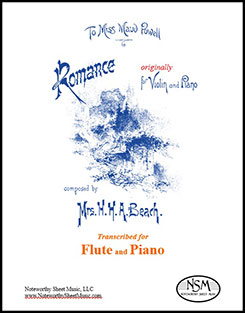 Romance, Op.23, by Mrs. H. H. A. Beach
Romance, Op.23, by Mrs. H. H. A. Beach
Transcribed for Flute and Piano by C. A. Vater (originally for violin and piano)
Piano Score and Flute Part, PDF $8.99
Amy Marcy Cheney, who used Mrs. H. H. A. Beach as her professional name after marrying a Boston physician, began composing music at the age of four; throughout her lifetime she wrote more than 150 numbered works spanning a variety of genres. Her pieces were received with great acclaim, and she became one of America’s leading composers and the first American woman composer to achieve widespread recognition in the United States and abroad. She was also a renowned concert pianist. Beach composed her Romance for Violin and Piano in 1893 for the occasion of the Women’s Musical Congress held the same year in Chicago during the World’s Columbian Exposition. The piece was dedicated to the celebrated violinist Maud Powell, who joined Beach for the premiere performance at that Congress. Highly romantic, melodic, charming, and passionate, the Romance is also technically complex yet graceful. With a few modifications of the violin line, this gorgeous piece works nicely on flute; we provide both our NSM transcribed flute part and a score for flute and piano.
Score, 8 pages; Flute part, 2 pages; Total, 14 pages.
PreviewBeethoven - Adelaide - Flute & Piano
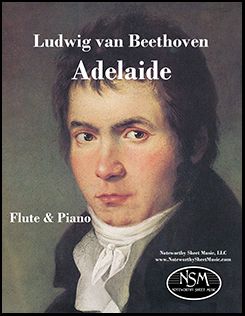 Adelaide, by Ludwig van Beethoven
Adelaide, by Ludwig van Beethoven
Anonymous Arrangement for Flute, each edition with a Foreword by P. H. Bloom
New Edition, Flute Part and Piano Score (flute part in small staff) – PDF $10.50
Facsimile Edition, Flute Part and Piano Score (original with clarinet part in small staff) – PDF $8.25
Beethoven completed his musical setting for Friedrich von Matthison's poem Adelaide in 1796. The song quickly became a favorite interpretive vehicle for instrumentalists as well as singers. Clarinetist Iwan Müller's "bel canto" treatment, essentially the original melody with added ornaments, cadenzas, and interpretive notations, remained a favorite among concertizing clarinetists for more than a century. It's likely that Müller's work informs the anonymous arrangement for flute, published by Diabelli in the second quarter of the 19th century, that we present here .... This anonymous paraphrase of Adelaide is a masterful study of the subtle nuance and passionate restraint of "bel canto" instrumental praxis. (excerpted from the foreword © by P. H. Bloom)
After offering our facsimile edition of Adelaide for some time, we decided to create a newly-notated modern edition as well. We love (and perform) this piece so much, that we didn't want anyone to forgo an opportunity to acquaint themselves with it merely due to the 19th century presentation of the facsimile. Now, there is a choice between the facsimile edition and a modern edition, the latter of course having the flute part in small staff in the score.
Preview================
Berbiguier - Grande Fantaisie - Flute & Piano
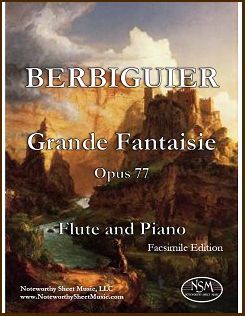 Grande Fantaisie, Op. 77, by T. Berbiguier
Grande Fantaisie, Op. 77, by T. Berbiguier
Gassett Collection - Facsimile Edition by C.A.Vater/Noteworthy Sheet Music, with a Foreword by Peter H. Bloom
Flute and Piano Parts, PDF $16.99
Benoit Tranquille Berbiguier (1782-1838) was among the preeminent European flutists of the early nineteenth century. Berbiguier was a prolific composer, and his nearly 150 published works include sets of duos and trios for flutes, as well as music that features flute with piano, orchestra, and chamber ensembles. His Grande Fantaisie avec Variations pour Flûte avec Accompagnement de Piano Forte (Opus 77) was composed on two motifs from Der Freischütz, Carl Maria von Weber's monumental opera which premiered in Berlin in 1821 and became an immediate international sensation. Sheet music for flute and piano.
For additional information about the Gassett Collection, please see see our article An Introduction to the Gassett Collection.
Piano part, 9 pages; Flute part, 8 pages; Total, 24 pages.
Berbiguier - Les Regrets - Flute & Piano
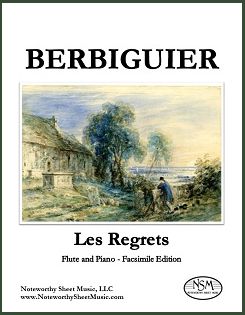 Les Regrets, Op.104, by T. Berbiguier
Les Regrets, Op.104, by T. Berbiguier
Gassett Collection - Facsimile Edition by C.A.Vater/NSM, with a Foreword by Peter H. Bloom
Flute Part and Piano Score, PDF $18.00
Berbiguier dedicated Les Regrets (Mélodie Concertante, Opus 104) to his close friend, the composer-'cellist Pierre-Louis Hus-Desforges. Les Regrets appears to be a missive of consolation from one musical colleague to another, both disillusioned and scarred veterans of decades of nationalist French intrigue. Though the initial theme is a plaintive rendering of a dour dead-march, its development is mournfully elegant. The subsequent developments serve to uplift performer and listener with a musical meditation that, though turbulent, avoids bathos. Dashes of a bit of scherzo here and there move the music, ultimately, to an heroic major-key finale.
For additional information about the Gassett Collection, please see see our article An Introduction to the Gassett Collection.
Piano score, 18 pages; Flute part, 6 pages; Total, 32 pages.
PreviewBerbiguier - Nouvelle Fantaisie - Flute & Piano
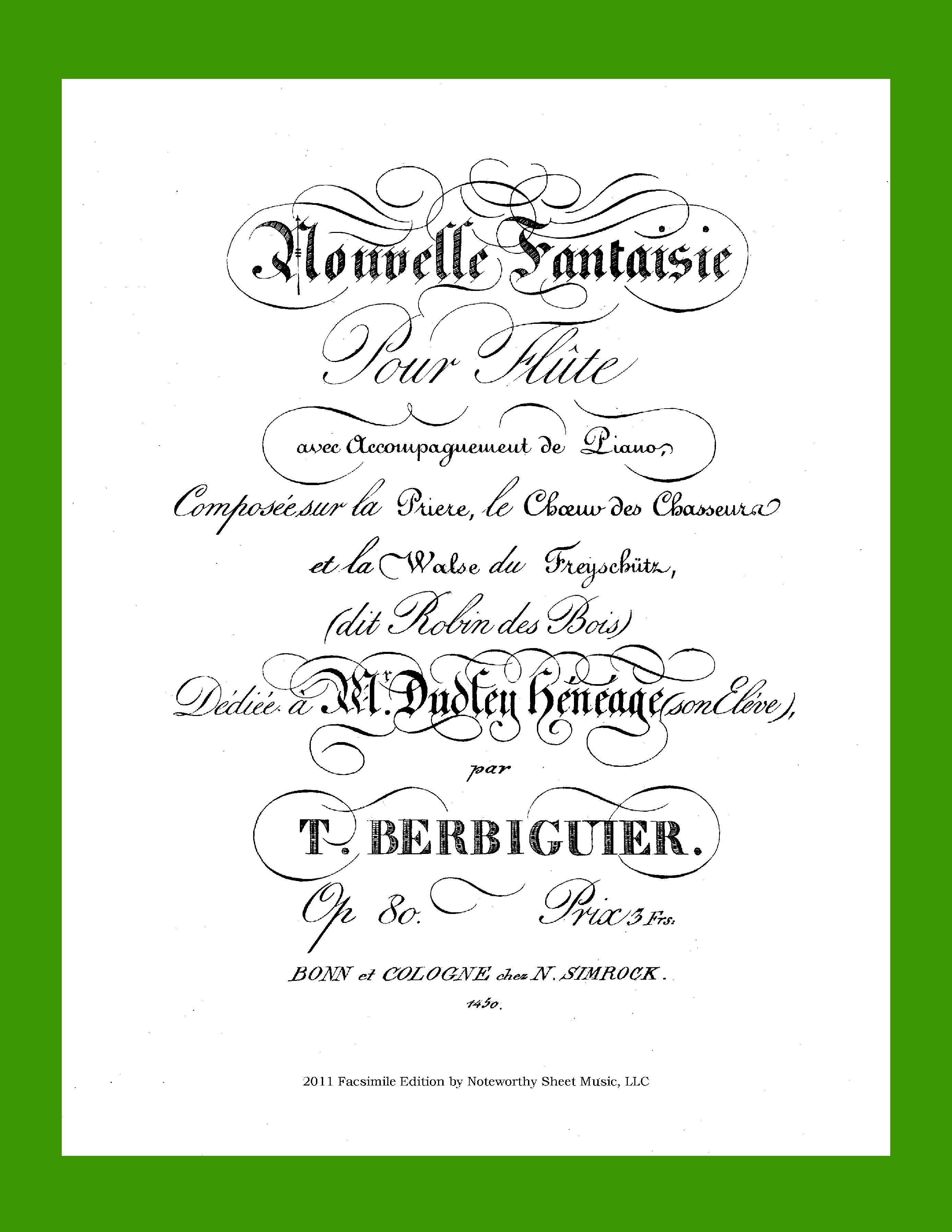 Nouvelle Fantaisie pour Flûte, Op. 80, by T. Berbiguier
Nouvelle Fantaisie pour Flûte, Op. 80, by T. Berbiguier
Gassett Collection - Facsimile Edition by C.A.Vater/Noteworthy Sheet Music, with a Foreword by Peter H. Bloom
Flute and Piano Parts, PDF $13.50
Berbiguier's Nouvelle Fantaisie (Opus 80), like his Grande Fantaisie (Opus 77), was composed on melodies from Carl Maria von Weber's genre-defining opera Der Freischütz. Both pieces were published around 1825. Enthusiasm for Der Freischütz continued to build in subsequent decades, as evinced by the nearly numberless fantaisies, paraphrases, souvenirs, and variations that have been published. Melodies from Freischutz pervade the classic repertoire of instruments from aeolian pianola to zither, including examples for concertina, mandolin, saxophone, and ocarina quartet. Piano and flute sheet music.
For additional information about the Gassett Collection, please see see our article An Introduction to the Gassett Collection.
Piano part, 11 pages; Flute part, 7 pages
PreviewBriccialdi - Fantaisie pour la Flûte - Fl & Pf
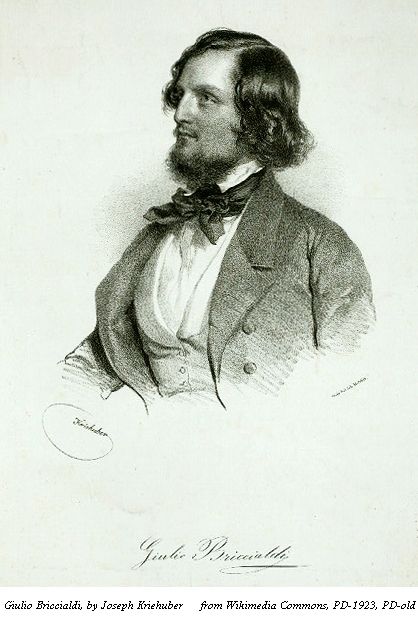 Fantaisie pour la Flûte, Op.110, by Briccialdi
Fantaisie pour la Flûte, Op.110, by Briccialdi
Gassett Collection - Facsimile Edition by C.A.Vater/Noteworthy Sheet Music
Flute Part and Piano Score, PDF $13.50
The virtuoso Italian flutist Giulio Briccialdi (1818-1881) was a captivating performer and a brilliant and prolific composer of works for the flute. His compositions became highly popular among flutists and include several concerti and numerous duets, caprices, fantasies, and etudes. He served as professor of flute at the Academy of St. Cecilia in Rome and later at the Florence Conservatoire. A proponent of the Boehm flute, Briccialdi is best known today for his invention of the Briccialdi B-flat thumb key and for his variation on the Carnival of Venice, "Il Carnevale di Venezia" (Op.78). We offer here our facsimile edition of his charming, challenging, and otherwise unavailable Fantaisie pour la Flûte sur des motifs de l'opera La Sonnambula de Bellini (Op.110).
For additional information about the Gassett Collection, please see see our article An Introduction to the Gassett Collection.
Piano score, 13 pages; Flute part, 5 pages; Total 23 pages.
PreviewBridge – 4 More Short Pieces – Flute or Alto Flute (and Piano)
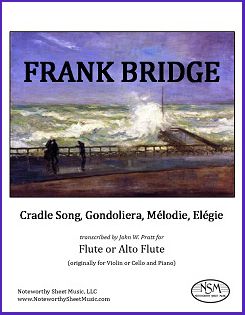 Cradle Song, Gondoliera, Mélodie, and Elégie, by Frank Bridge
Cradle Song, Gondoliera, Mélodie, and Elégie, by Frank Bridge
Transcribed for Flute or Alto Flute (and Piano) by J. W. Pratt
Flute Part, Alto Part, PDF $11.99
Like the 4 Short Pieces for Violin and Pianoforte published in transcription by Noteworthy Sheet Music previously, these additional four short pieces by Bridge "provide a fine and delightful introduction to an accessible post-romantic composer who should be better known." Published by Bridge between 1903 and 1911, the works included in our second edition are transcriptions of Cradle Song, written for violin or cello and piano, Gondoliera for violin and piano, and Mélodie and Elégie for cello and piano. Mr. Pratt has created transcriptions of all four pieces for both flute and alto flute, and we include both instrument versions in this combined edition. We think Cradle Song and Elégie are particularly beautiful on the alto flute, but all are effective on either instrument, so we prefer to let our flutists decide on which instrument they choose to play each piece. We provide our flute and alto flute parts only; the original piano scores work well with our transcriptions and are available, along with the violin and cello parts, as free pdf downloads at imslp.org—click the links to access the scores for Cradle Song, Gondoliera, Mélodie, and Elégie.
Flute part, 6 pages; Alto Flute part, 6 pages; Total, 14 pages.
PreviewBridge – 4 Short Pieces – Flute or Alto Flute (and Piano)
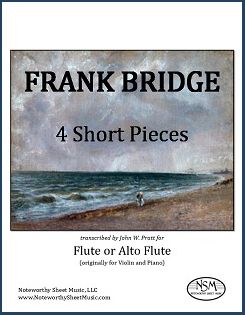 4 Short Pieces, by Frank Bridge
4 Short Pieces, by Frank Bridge
Transcribed for Flute or Alto Flute (and Piano) by J.W.Pratt
Flute Part, Alto Part, PDF $8.99
The 4 Short Pieces by Frank Bridge were written for violin and piano, and first published in 1912. As noted in John Pratt's foreword to the edition, they "provide a fine and delightful introduction to an accessible post-romantic composer who should be better known." The pieces are Meditation, Spring Song, Lullaby, and Country Dance. Mr. Pratt has created transcriptions of the violin parts for both flute and alto flute, and we include both instrument versions in this edition. We think Nos. 1 and 3 sound particularly nice on the alto flute and No. 4 is a splendid romp on the C flute, but all four are effective on either instrument, so we prefer to let our flutists decide on which instrument they choose to play each piece. We provide only our flute and alto flute transcriptions; the piano score, including the original violin part, is available as a free pdf download at imslp.org.
Flute part, 5 pages; Alto Flute part, 5 pages; Total, 14 pages.
PreviewBurleigh - Southland Sketches, Nos. I, III, IV - Alto Flute or Flute (& piano)
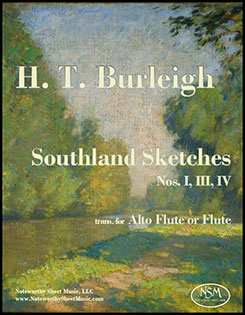 Southland Sketches, Nos. I, III, IV, by H. T. Burleigh
Southland Sketches, Nos. I, III, IV, by H. T. Burleigh
Transcribed for Alto Flute or Flute (and piano) by C. A. Vater
Alto Flute part and Flute part, PDF $9.96
Harry Thacker Burleigh was an acclaimed African-American singer, music editor, and composer whose adaptations of African-American spirituals became famous. His Southland Sketches, which were composed for violin and piano and published by G. Ricordi in 1916, are a fine example of Burleigh’s quintessential American style. The original composition included 4 movements. Our edition excludes the second movement, but adapts three of the original four miniatures for either alto flute or flute. We provide only the transcribed alto flute and flute parts, as they have been designed to work well with the piano part in the original score for violin and piano which is available as a good quality, free pdf download from imslp.org. Performers may choose to play all three of these pieces on either flute or alto flute, or switch instruments between sketches, depending on personal preference.
Alto Flute part, 6 pages; alternate Flute part, 6 pages; Total,18 pages. (pdf of piano accompaniment is freely available at imslp.org)
Preview